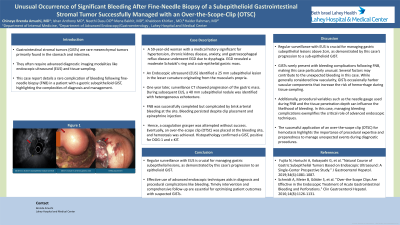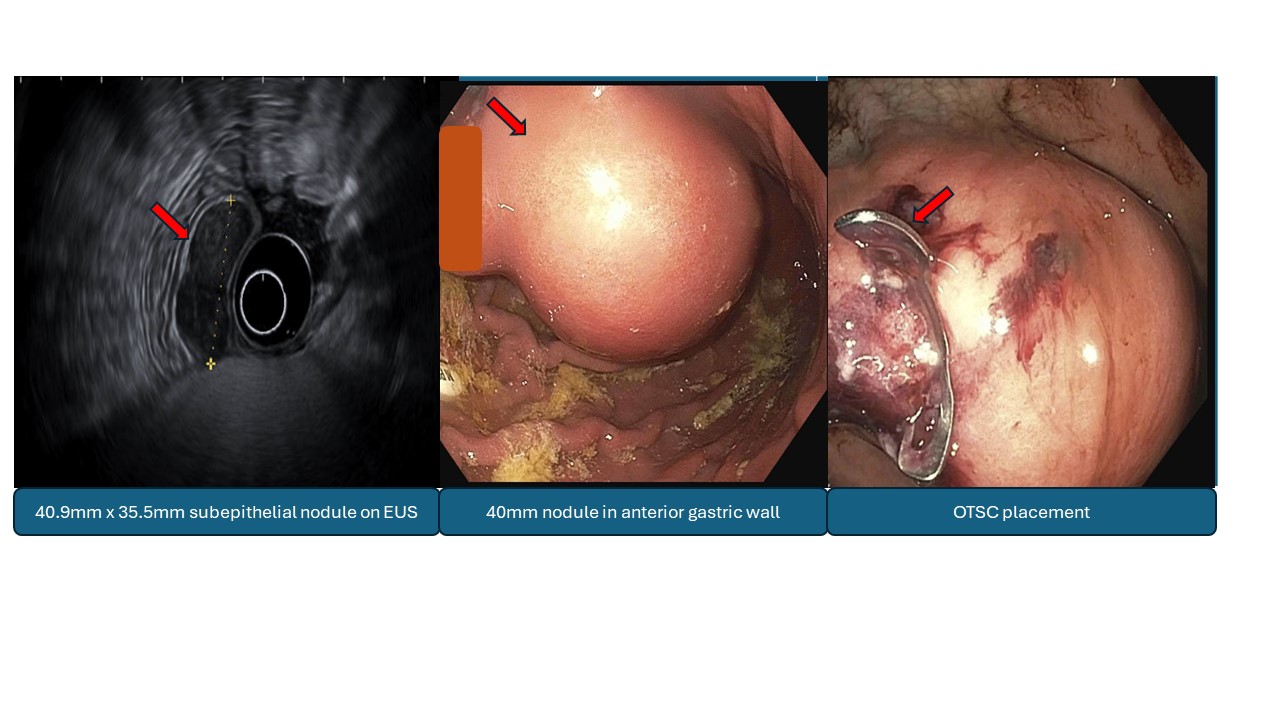Tuesday Poster Session
Category: Interventional Endoscopy
P4524 - Unusual Occurrence of Significant Bleeding After Fine-Needle Biopsy of a Subepithelioid Gastrointestinal Stromal Tumor Successfully Managed with an Over-the-Scope-Clip (OTSC)
Tuesday, October 29, 2024
10:30 AM - 4:00 PM ET
Location: Exhibit Hall E

Has Audio

Chineye Brenda Amuchi, MD, MPH
Beth Israel Lahey Health
Burlington, MA
Presenting Author(s)
Chineye Brenda Amuchi, MD, MPH1, Neethi Dasu, DO1, Khaldoon Khirfan, MD1, Mena Bakhit, MD2, Haider Rahman, MD2, Mythri Subramaniam, MD2
1Beth Israel Lahey Health, Burlington, MA; 2Lahey Hospital and Medical Center, Burlington, MA
Introduction: Gastrointestinal stromal tumors (GISTs) are rare mesenchymal tumors primarily found in the stomach and intestines. They often require advanced diagnostic imaging modalities like endoscopic ultrasound (EUS) and tissue sampling. This case report details a rare complication of bleeding following fine-needle biopsy (FNB) in a patient with a gastric subepithelioid GIST, highlighting the complexities of diagnosis and management.
Case Description/Methods: A 59-year-old woman with a medical history significant for hypertension, chronic kidney disease, anxiety, and gastroesophageal reflux disease underwent EGD due to dysphagia. EGD revealed a moderate Schatzki's ring and a sub-epithelial gastric mass. An Endoscopic ultrasound (EUS) identified a 25 mm subepithelial lesion in the lesser curvature originating from the muscularis propria. One year later, surveillance CT showed progression of the gastric mass. During subsequent EUS, a 40 mm subepithelial nodule was identified with heterogeneous echotexture. FNB was completed but complicated by brisk arterial bleeding at the site. Bleeding persisted despite clip placement and epinephrine injection. Hence, a coagulation grasper was attempted without success. Eventually, an over-the-scope clip (OTSC) was placed at the bleeding site, and hemostasis was achieved. Histopathology confirmed a GIST, positive for DOG-1 and c-KIT.
Discussion: Regular surveillance with EUS is crucial for managing gastric subepithelial lesions above 2cm, as demonstrated by this case's progression to a sub-epithelioid GIST. GISTs rarely present with bleeding complications following FNB, making this case particularly unusual. Several factors may contribute to the unexpected bleeding in this case. While generally considered low vascularity, GISTs occasionally harbor vascular components that increase the risk of bleeding during tissue sampling. Additionally, procedural variables such as the needle gauge used during FNB and the tissue penetration depth can influence the likelihood of bleeding. In this case, managing bleeding complications exemplifies the critical role of advanced endoscopic techniques. The successful application of an over-the-scope clip (OTSC) for hemostasis highlights the importance of procedural expertise and preparedness to manage unexpected events during diagnostic procedures.

Disclosures:
Chineye Brenda Amuchi, MD, MPH1, Neethi Dasu, DO1, Khaldoon Khirfan, MD1, Mena Bakhit, MD2, Haider Rahman, MD2, Mythri Subramaniam, MD2. P4524 - Unusual Occurrence of Significant Bleeding After Fine-Needle Biopsy of a Subepithelioid Gastrointestinal Stromal Tumor Successfully Managed with an Over-the-Scope-Clip (OTSC), ACG 2024 Annual Scientific Meeting Abstracts. Philadelphia, PA: American College of Gastroenterology.
1Beth Israel Lahey Health, Burlington, MA; 2Lahey Hospital and Medical Center, Burlington, MA
Introduction: Gastrointestinal stromal tumors (GISTs) are rare mesenchymal tumors primarily found in the stomach and intestines. They often require advanced diagnostic imaging modalities like endoscopic ultrasound (EUS) and tissue sampling. This case report details a rare complication of bleeding following fine-needle biopsy (FNB) in a patient with a gastric subepithelioid GIST, highlighting the complexities of diagnosis and management.
Case Description/Methods: A 59-year-old woman with a medical history significant for hypertension, chronic kidney disease, anxiety, and gastroesophageal reflux disease underwent EGD due to dysphagia. EGD revealed a moderate Schatzki's ring and a sub-epithelial gastric mass. An Endoscopic ultrasound (EUS) identified a 25 mm subepithelial lesion in the lesser curvature originating from the muscularis propria. One year later, surveillance CT showed progression of the gastric mass. During subsequent EUS, a 40 mm subepithelial nodule was identified with heterogeneous echotexture. FNB was completed but complicated by brisk arterial bleeding at the site. Bleeding persisted despite clip placement and epinephrine injection. Hence, a coagulation grasper was attempted without success. Eventually, an over-the-scope clip (OTSC) was placed at the bleeding site, and hemostasis was achieved. Histopathology confirmed a GIST, positive for DOG-1 and c-KIT.
Discussion: Regular surveillance with EUS is crucial for managing gastric subepithelial lesions above 2cm, as demonstrated by this case's progression to a sub-epithelioid GIST. GISTs rarely present with bleeding complications following FNB, making this case particularly unusual. Several factors may contribute to the unexpected bleeding in this case. While generally considered low vascularity, GISTs occasionally harbor vascular components that increase the risk of bleeding during tissue sampling. Additionally, procedural variables such as the needle gauge used during FNB and the tissue penetration depth can influence the likelihood of bleeding. In this case, managing bleeding complications exemplifies the critical role of advanced endoscopic techniques. The successful application of an over-the-scope clip (OTSC) for hemostasis highlights the importance of procedural expertise and preparedness to manage unexpected events during diagnostic procedures.

Figure: Description of EGD and EUS findings
Disclosures:
Chineye Brenda Amuchi indicated no relevant financial relationships.
Neethi Dasu indicated no relevant financial relationships.
Khaldoon Khirfan indicated no relevant financial relationships.
Mena Bakhit indicated no relevant financial relationships.
Haider Rahman indicated no relevant financial relationships.
Mythri Subramaniam indicated no relevant financial relationships.
Chineye Brenda Amuchi, MD, MPH1, Neethi Dasu, DO1, Khaldoon Khirfan, MD1, Mena Bakhit, MD2, Haider Rahman, MD2, Mythri Subramaniam, MD2. P4524 - Unusual Occurrence of Significant Bleeding After Fine-Needle Biopsy of a Subepithelioid Gastrointestinal Stromal Tumor Successfully Managed with an Over-the-Scope-Clip (OTSC), ACG 2024 Annual Scientific Meeting Abstracts. Philadelphia, PA: American College of Gastroenterology.

